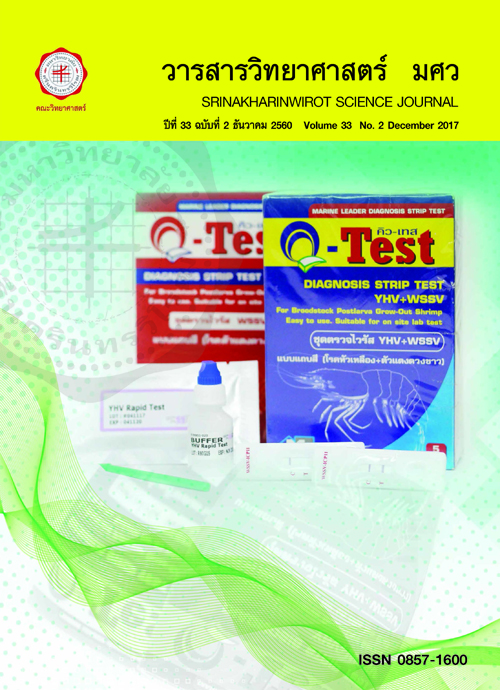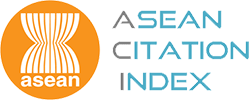การประยุกต์ใช้แบบจำลอง SWAT เพื่อศึกษาการเปลี่ยนแปลงการใช้ประโยชน์ที่ดิน ต่อปริมาณตะกอนแขวนลอย ในลุ่มน้ำท่าจีนตอนบน
Keywords:
SWAT Model, Land Use Changes, Suspended Sediment, Upper Tha Chin WatershedAbstract
บทคัดย่อ งานวิจัยนี้มีวัตถุประสงค์เพื่อศึกษาการเปลี่ยนแปลงการใช้ประโยชน์ที่ดินต่อปริมาณตะกอนแขวนลอยในลุ่มน้ำท่าจีนตอนบน โดยการประยุกต์ใช้แบบจำลอง SWAT ในการประเมินปริมาณตะกอนแขวนลอยจากการใช้ประโยชน์ที่ดินในช่วงปี พ.ศ. 2556-2557 (กรณี Scenario 1) และสอบเทียบความถูกต้องของแบบจำลองจากข้อมูลการตรวจวัดของ 6 สถานี โดยการปรับค่าสัมประสิทธิ์พารามิเตอร์ที่สำคัญโดยใช้โปรแกรม SWAT CUP ซึ่งความถูกต้องและความเหมาะสมพิจารณาจากค่าสัมประสิทธิ์ตัวกำหนด (R2) ความแม่นยำของแบบจำลอง (NSE) และร้อยละของความแตกต่าง (MSE) พร้อมทั้งจำลองสถานการณ์การใช้ประโยชน์ที่ดินในปี พ.ศ. 2563 (กรณี Scenario 2) ผลการศึกษาที่ได้จากแบบจำลอง SWAT พบว่า ลุ่มน้ำท่าจีนตอนบนมีขนาดพื้นที่ เท่ากับ 5,253.96 ตารางกิโลเมตร แบ่งออกเป็น 14 ลุ่มน้ำย่อย และ 286 หน่วยตอบสนองทางอุทกวิทยา จากการศึกษา พบว่า ในช่วงกรณี Scenario 1 ลุ่มน้ำท่าจีนตอนบนมีปริมาณตะกอนแขวนลอย เท่ากับ 1,854,720 ตัน/ปี ส่วนช่วงกรณี Scenario 2 ลุ่มน้ำท่าจีนตอนบนมีปริมาณตะกอนแขวนลอยเพิ่มขึ้น เท่ากับ 5,065,445 ตัน/ปี เมื่อเทียบกับช่วงกรณี Scenario 1 เนื่องจากลดลงของพื้นที่ป่าไม้ผลัดใบและการเพิ่มขึ้นของพื้นที่พืชไร่ - - - Application of SWAT Model for Studying Land Use Changes on Suspended Sediment in Upper Tha Chin WatershedABSTRACTThe objective of this work was to study the land utilization on amount of suspended sediment in Upper Tha Chin Watershed (UTCW). The SWAT (Soil and Water Assessment Tool) model was applied to estimate amount of the suspended sediment from land utilization during 2013 and 2014 (Scenario 1). The reliability of the model was calibrated with the observed data from 6st hydrologic stations by adjusting the coefficient of the key parameters by using SWAT CUP program. The goodness of the calibration results were assessed based on the coefficient of determination (R2), Nash-Sutcliffe efficiency coefficient (NSE) and mean squared error (MSE) along with simulating the impact of land utilization in 2020 (Scenario 2). The results from SWAT model showed that the UTCW area was 5,253.96 km2, 14 sub-watersheds and 286 hydrological response units. The Scenario 1 indicated that the suspended sediment of the UTCW was 1,854,720 tons/year. The simulation of the Scenario 2 found that the suspended sediment of the UTCW increased to 5,065,445 tons/year compared to the Scenario 1 because of decreasing in forest-deciduous and increasing in field crops.Downloads
Download data is not yet available.
Downloads
Published
2017-08-04
How to Cite
ฟักสมบูรณ์ บ., & ตั้งธรรม น. (2017). การประยุกต์ใช้แบบจำลอง SWAT เพื่อศึกษาการเปลี่ยนแปลงการใช้ประโยชน์ที่ดิน ต่อปริมาณตะกอนแขวนลอย ในลุ่มน้ำท่าจีนตอนบน. Science Essence Journal, 33(2), 123–140. Retrieved from https://ejournals.swu.ac.th/index.php/sej/article/view/8141
Issue
Section
Research Article








